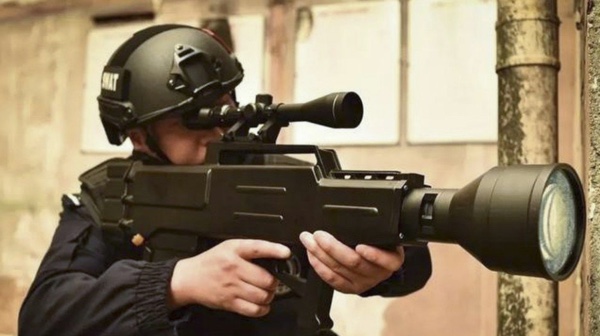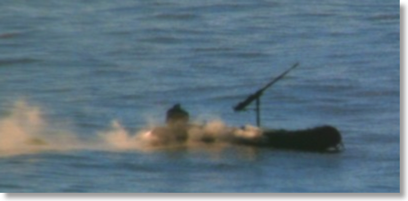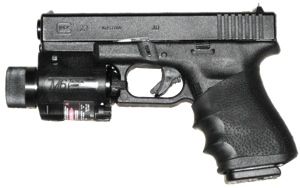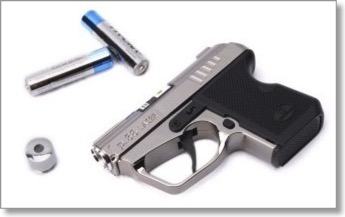Home
A comprehensive resource for safe and responsible laser use
China: "Laser AK-47" assault rifle said to be manufactured; experts skeptical

The July 1 2018 report appeared the In South China Morning Post. It quoted a “researcher who had [taken] part in the development and field testing of a prototype at the Xian Institute of Optics and Precision Mechanics at the Chinese Academy of Sciences in Shaanxi province. The source said “The pain will be beyond endurance.” Another researcher said that because the beam is invisible and noiseless, “nobody will know where the attack came from. It will look like an accident.”
A technical document stressed the “non-lethal” nature of the laser rifle, listing attacks such as burning the banners or clothing of “illegal protests”.
The laser capability claims were disputed, however, by numerous news outlets.
TechCrunch writer Devin Coldewey first noted that military laser systems capable of delivering damaging heat over hundreds of meters require “on the order of tens of kilowatts, and those have trouble causing serious damage.” He calculated that a Tesla Powerwall using lithium ion batteries produces a few kilowatts of power and weighs over 200 pounds. (The complete laser rifle weighs 6.6 pounds.) Coldewey said the problem was atmospheric attenuation of the laser beam which is “non-trivial at anything beyond, say, a few dozen meters. By the time you get out to 800 [meters, the laser’s claimed range] the air and water the beam has traveled through [are] enough to reduce it [to] a fraction of its original power.”
Israel: Laser-equipped drones to fight incendiary kites and balloons
From late March to mid-June 2018, 450 fires caused by the aerial attacks burned about 7,500 acres of farmland and national parks, including 1,400 acres of wheat.
In response, the IDF has developed systems to locate the kites and balloons, either intercepting them or sending fire fighters to the landing locations. One interception technique uses a laser on a drone that in tests “has been successful in incinerating the incoming trajectory, neutralizing it and bringing it down.” It is expected to be deployed “soon” according to news stories in late June 2018.
From the JewishPress.com, L.A. Times, and The Times of Israel
Ukraine: Developing countermeasures after 4 cases of laser eye injury
“We already had several such cases (a laser injury of the eye retina) in the State Border Guard Service and in the National Guard. We are now developing countermeasures. We do not fully understand what they use, but we are already working on the instructions what it could be. We will install the appropriate filters, devices, use appropriate glasses,” Avakov said.
He reported on four cases of the laser injury of border guards and national guardsmen.
“The use of such weapons is a barbarous situation. We will discuss it at the international level,” Avakov emphasized.
From Kyiv Post
General: How many laser pointers to kill a human?
Author Adam Clark Estes begins with a primer on laser light, and determines that the beams from many lasers would have to be focused on a single spot. Estes quoted Dr. Rebecca Thompson of the American Physical Society:
“…if you wanted to create a death ray with laser pointers, you could buy 200,000 laser pointers [cat-toy type with 5 milliwatt output each], mount them on a piece of a sphere with radius 5.5’, aim them all through a lens and ask your victim to sit very, very still.”
The article concludes “Do not try this at home.”
From Gizmodo. Thanks to Roberta McHatton for bringing this to our attention.
UK: BALPA calls for high-powered lasers to be treated as offensive weapons
BALPA noted that there were 1,439 reports of laser attacks in 2015, and that 55% of pilots experienced a laser attack in the past 12 months. A spokesperson said BALPA “has been campaigning for a long time for high-powered lasers to be treated as what they are — offensive weapons.”
The association was also concerned with the threat of incidents involving drones.
A motion to ask for improved regulations passed at the meeting.
From a BALPA press release
India, Kashmir: Hundreds of severe eye injuries from government pellet shotguns (not a laser)
An August 28 2016 New York Times article describes some of the lead pellet-caused eye injuries:
“The patients have mutilated retinas, severed optic nerves, irises seeping out like puddles of ink.”
“[A] patient’s eyelids have been stretched back with a metal clamp, so his eyeball bulges out of glistening pink tissue. The surgeon sits with his back very straight, cutting with tiny movements of his fingers. Every now and then, a thread of blood appears in the patient’s eye socket. The patient is 8 years old…. Slowly, as residents stood around him in hushed silence, the surgeon flattened out the boy’s retina, as thin and delicate as a lace doily, and used a laser to reattach it to the back of his eye.
“In most cases, it became clear, the pellets had burst into through the cornea and out through the retina, leaving little hope of fully restoring vision…. ‘Once it goes in the eye, it rotates like this, and destroys everything there inside,’ Dr. Qureshi said. ‘It’s physics. This is a high-velocity body. It releases a high amount of energy inside. The lens, the iris, the retina get matted up.’”
The author, Ellen Barry, notes that “….most countries do not use them on unarmed civilians, as the pellets spray widely and cannot be aimed…. This year, the use of pellets on Kashmiri protesters increased sharply, with the police firing more than 3,000 canisters, or upward of 1.2 million pellets, in the first 32 days of the protests, the Central Reserve Police Force has said.”
From the New York Times
Note: This story is part of our occasional coverage of eye injuries at protests which were not caused by a laser. This is because the number of actual or claimed laser eye injuries at protests (generally inflicted on police or security forces) is vastly outnumbered by actual or claimed eye injuries to protesters, journalists and bystanders (generally caused by police or security forces). In our view, no one should aim a laser or projectile at anyone's eye or head during protests, demonstrations and civil unrest.
US: Lockheed Martin demos laser that can burn holes in rubber boats from a mile away

A YouTube video shows infrared and visible footage of the test.
The 10-kilowatt High Energy Laser (HEL) system previously demonstrated an ability to track, target and destroy rockets traveling at high speed.
From Gizmag and Engadget
Israel: Lasers on airplanes used to deflect missiles

The C-MUSIC system mounted on a Boeing 737-800
The system was developed after a 2002 incident in Kenya where terrorists fired two surface-to-air missiles at an Israeli charter plane carrying more than 250 passengers; the missiles missed their target. C-MUSIC will be added to all El Al aircraft. In addition, the developer Elbit Systems has contracts with other countries besides Israel.
From Wired via Ubergizmo
Switzerland: Police want higher power laser pointers classed as weapons
Since 2011, laser pointers above 5 milliwatts are prohibited in Switzerland. The Swiss Federal Office of Public Health is working on proposals to classify laser pointers as weapons and will present these by 2014.
From 20 Minuten (original German text and Google-translated into English)
Worldwide: Laser weapons 10-20 years away from widespread deployment
One speaker noted “…we have had kinetic weapons for 500 years and laser weapons for 10-15 years…. The soldier wants a reliable, easy-to-handle, clear to understand system that has the reliability of a normal M16 rifle, or whatever, therefore the superiority is on the kinetic side.”
From Optics.org
General interest: Article discusses pros and cons of laser sights for weapons
Author John Wills notes that laser sights are not as effective beyond 20 feet, and they do not substitute for marksmanship techniques such as grip and stance.

Glock Model 23 with M6 Tactical Laser Illuminator (xenon light plus red laser pointer < 5 mW).
Image from nukeit1 at Flickr, CC by 2.0 license.
Green laser sights are now available; they are more easily seen than an equivalent-power red laser. Infrared laser sights are made for use with night vision goggles. The beam cannot be seen by the naked eye, so a bad guy does not even know he is being targeted.
Wills concludes by saying “like any other tool there is a right way and a wrong way to use” lasers.
From Officer.com
US: "The Straight Dope" answers the question "Should I be afraid of laser pointers?"
The answer first noted that laser weapons are large. An anti-missile laser required a Boeing 747, the Navy set fire to a boat with a destroyer-mounted laser, and a dazzler-type laser called the PHaSR is as portable “as a bag of cement.”
Then, Straight Dope purchased a 1 watt blue handheld laser (the same or similar to the Wicked Lasers Spyder III Arctic). They aimed it at room temperature pork chops and bacon. From one foot away, it took 27 seconds of continuous exposure before smoke appeared. Even with matches, it took 11 seconds to light a match from one foot away, and 15 seconds from 32 feet away.
The January 6 2012 column concluded that handheld laser ray guns are not practical: “…the likelihood that this laser would actually change somebody’s mind (other than via intimidation alone) is virtually nil…. no bad guy is going to sit still while you fry him.”
Story and photos are at the Straight Dope website. The column was also printed in the Washington City Paper.
UPDATE: In comments at the Washington City Paper, “dave b” noted that exposure to skin isn’t necessarily the important factor: “The key is to get the laser into someone’s eye.”
.
US: Report says Iran blinded CIA satellite with laser
This was the only laser-related information in a December 15 2011 article that was otherwise about Iran tricking a U.S. drone into landing in Iran by jamming its GPS position signals.
From the Christian Science Monitor; the laser paragraph was on page 2 of the online story. See also an October 2011 Washington Post story analyzing a politician’s claim that China blinded U.S. satellites in 2006.
.
UK: BALPA wants lasers classified as weapons and banned EU-wide
From The Independent and the Daily Mail
.
US: Politician says China blinded U.S. satellites with lasers
US: UPDATED - Gun-shaped laser pointer for sale

The seller says this is “a good tool for pointing to the faraway target or stars and sending out the SOS signal, making your travelling [sic] funny and interesting.” Fortunately, they also note that “Laser is harmful to people, following uses are forbidden: A. Point the laser at people's faces, especially eyes; B. Point at mirrors or highly reflective surface; C. For children play; D. Observe the laser lines with a telescope; E. Disassemble, test or repair laser pens.”
Thanks to Phyllis Monahan of Lighting Systems Design Inc. (LSDI) for bringing this to our attention.
UPDATED - June 7 2011: Gun-shaped laser pointers have been noted in two police reports we have recently seen. One is a confiscation in Virginia Beach after a teen aimed a gun/pointer at a mounted policeman and his horse. The other is a May 7 incident reported by the Buffalo Grove (Illinois) Patch where police briefly detained youths who had been pointing a gun-shaped laser pointer at vehicles in a parking lot. “The officer contacted the parents who came to pick up their sons. The officer made it very clear to the parents and the youths how dangerous a situation the boys placed themselves into.”
UPDATE 2 - September 16 2014: A 13-year-old Indiana boy was suspended for a week from school, for waving a laser pointer around in a school parking lot. Police said the laser pointer “could look like a gun.” It is unknown if the pointer actually was gun-shaped like in the above photo, or if it was a different shape, such as the cylinder of a barrel, that could be mistaken for a gun.
US: Pentagon delayed using laser dazzers in Iraq
During the U.S. phase of the Iraq war, Marine Corps leaders requested the handheld devices as a way to warn and stop drivers who were overrunning military checkpoints. Wired’s David Axe estimates that “as many as 50” Iraqi civilians were killed by gunfire -- instead of being forced off the road by dazzlers -- during the nine month delay.
There is some dispute over the safety of laser dazzlers. According to the Inspector General’s report,
Laser dazzlers provide a nonlethal capability by emitting an intense light capable of temporarily obscuring the vision of approaching individuals; however, using lasers poses a risk of serious eye injury and permanent blindness. This mode of employing a laser, shining a laser directly into the face or eyes, increases the inherent dangers of using the laser. Using nonlethal laser dazzlers would give Marine operating forces an additional capability to increase stand-off distances, safeguard civilians who venture too close to Marine positions, and help prevent unwarranted escalation of force incidences; however, DoD [Department of Defense] policy prohibits the use of lasers designed to cause permanent blindness. Operating procedures and laser safety measures are essential to ensure the safe and proper use of the lasers.
The Inspector General’s report contains additional details about the range, capabilities, safety concerns and policy issues related to military use of laser dazzlers. For example, the 1995 Protocol on Blinding Laser Weapons states that the signatories (which include the U.S.) “shall take all feasible precautions to avoid the incidence of permanent blindness to unenhanced vision.”
From Wired.com.
NSW: Fine for possession, prison for dangerous use
Ms Spence said: “This government is committed to cracking down on these reckless and idiotic individuals, and that is why we have previously announced we are introducing new legislation regarding the possession and use of laser pointers.
“Under changes to the Weapons Act which I announced in July, following the Weapons Act Review, it will become an offence to be in possession of a laser pointer, without a reasonable explanation. Click to read more...